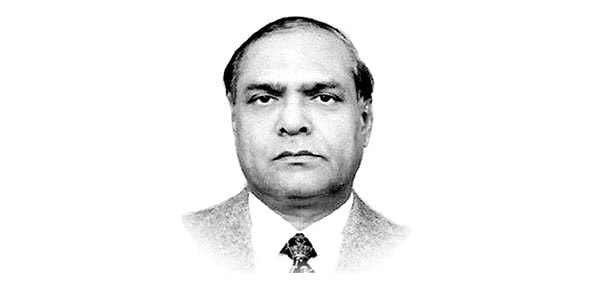Multiple challenges for Pakistan
IT has become customary for politicians in our country to indulge in blame game when it comes to issues facing the country particularly governance.
In fact governance has also been a colossal dilemma for every political government for various reasons, major being apathy at the highest level and putting governance at the bottom of priorities.
The result is before us all to see and realize our blunders.Corruption has thrived and has reached level, never seen before.
Respect for law is at the lowest ebb. Fear of being penalized and punished for breaking law has disappeared.
The most glaring manifestation of this can be seen on the roads where big vehicle drivers with armed guards and fluttering flags jump red traffic light at will and poor traffic warden and traffic constable watch it, helplessly.
Bike riders openly flout traffic rules and seldom follow “One way” traffic sign. This is a new phenomenon.
Rewind it 2/3 decades and you would know what law was. People never thought of flouting rules, which is now an every day sight, these days.
Corruption was extremely limited and not open as it is now.Go to any government office and you will know where we stand.
Unless you grease the palms of functionaries, nothing moves. On the contrary, every possible obstacle will be put in your way unless their extra-ordinary demands are not fulfilled.
The question arises why and how have we reached this level of moral bankruptcy? A million dollar question though but easy and simple to get the answer.
Take any simple household. If the head of a family in a house is gambler, drunkard, ill-tempered and has all the known vices, there are all the chances that his children, most likely, will follow suit and do what they have seen their elders doing.
The other most important factor is the use of money. The old saying that money either spoils you or makes you is true for all times.
Those who have extra money (usually made from corruption or other illegal means) puts one on the wrong path and children acquire bad habits and go astray.
This is common sight prevalent, these days. Easy money has not only spoiled our youths but has created a culture of filthy rich who consider themselves above law and openly indulge in anti-moral activities.
With alarming gap between rich and poor, which is increasing with every day passing, the rising class difference between these is a matter of great concern.
On the other hand, the poor are getting poorer thus creating a distinct class of “haves and have nots”.
History is replete with instances where such developments and situations were the main cause of revolutions, often bloody.
French revolution is one such example.Unless we have honest, sincere and upright leaders whose integrity is unquestionable, our dilemma will never end.
The irony is that our leaders are in deep slumber.Like ostriches we put head in the sand, hoping everything is ok or will be ok.
Well, everything is not ok.By closing your eyes to a reality you are only allowing a ticking bomb to explode, sooner or later, one day.
The Government must take cognizance of this monstrous evil before it is too late and must take stringent steps to curb and stop this trend and start taking remedial measures before things go beyond any one’s control.
According to Human Development Report 2020, Pakistan’s overall share for the poorest income quintile is 14.2 percent, compared to 37.2 percent for the richest quintile.
Fortunately, the distribution of public expenditure is less unequal and contributes to reducing inequality.
But, attempts are urgently needed to increase this contribution by raising basic social services’ share in public expenditure, increasing cash transfers and widening the coverage of pension schemes.
Consequently, with the widening wealth inequality, access to services, and income generation, translate into a negative long-term impact on human development.
The poorest one per cent of the population holds only 0.15 per cent of national income, compared to the richest 1 per cent, which held nine per cent of national income in 2018-2019.
To reduce income inequality, the real per capita income of the poorest 40 percent of Pakistanis must grow at a rate that exceeds the income growth rate of the total population.
To unpack this finding, the NHDR 2020 divides income distribution into four periods.Between 2001 and 2012, the growth rate of per capita income of the poorest 40 percent was lower than the total population.
The gap was larger during 2001-2008 when there was relatively rapid growth in GDP.Between 2011 and 2019, the poorest 40 percent of Pakistanis saw their per capita income grow at a faster rate, while the economy witnessed 4 percent growth.
This implies that income distribution deteriorates during relatively fast economic growth.However, the NHDR 2020’s analysis shows that the plight of Pakistan’s middle class is worsening.
Based on per capita expenditure, only 36 percent of the population was middle class in 2018-2019, down from 42 percent 10 years earlier.
The pressure of inflation, unemployment among educated workers and decreasing purchasing power parity is ‘squeezing’ the middle class to the bottom of pyramid.
Foreign remittances and income from property are two major sources that underlie income inequality in Pakistan.
It is, therefore, no surprise that incomes generated through wealth can have a significant impact on income inequality.
Pakistan had a Human Development Index value of 0.570 in 2018-2019 which improved placing the country in the medium human development category.
However, Pakistan’s HDI value has only increased by 39 percent in the past 27 years, far less than the improvements in Bangladesh (59 percent) and India (52 per cent).
In fact, Pakistan has the second lowest HDI value in South Asia.
Improving human development means enhancing education, healthcare and income generation, the report concludes.
—The writer is former civil servant and consultant ILO and IOM.










